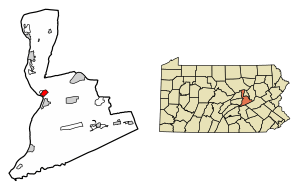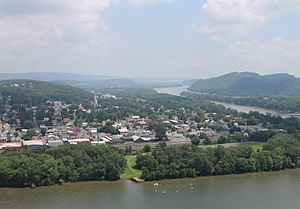Northumberland, Pennsylvania facts for kids
Quick facts for kids
Northumberland, Pennsylvania
|
|
|---|---|
|
Borough
|
|

View of Northumberland in July 2015
|
|
| Nickname(s):
"Norry"
|
|

Location of Northumberland in Northumberland County, Pennsylvania
|
|
| Country | United States |
| State | Pennsylvania |
| County | Northumberland |
| Settled | 1772 |
| Incorporated | 1828 |
| Government | |
| • Type | Borough Council |
| Area | |
| • Total | 1.61 sq mi (4.17 km2) |
| • Land | 1.61 sq mi (4.17 km2) |
| • Water | 0.00 sq mi (0.00 km2) |
| Elevation
(borough benchmark)
|
512 ft (156 m) |
| Highest elevation
(northern boundary of borough)
|
820 ft (250 m) |
| Lowest elevation
(confluence of West Branch and Susquehanna River)
|
430 ft (130 m) |
| Population
(2020)
|
|
| • Total | 3,911 |
| • Density | 2,429.19/sq mi (937.77/km2) |
| Time zone | UTC-5 (Eastern (EST)) |
| • Summer (DST) | UTC-4 (EDT) |
| ZIP Code |
17857
|
| Area code(s) | 570 and 272 |
| FIPS code | 42-55456 |
| Website | Northumberland borough |
Northumberland is a small town, called a borough, located in Northumberland County, Pennsylvania, United States. In 2020, about 3,911 people lived there. It's a place with a rich history and interesting sights.
Contents
History of Northumberland
Northumberland was founded in 1772 by a brewer named Reuben Haines from Philadelphia. He wanted to create a town that felt like an English village. The land was bought from the Iroquois people in 1768.
During the American Revolution, the town had to be emptied in 1778. This event was known as the Big Runaway. People only started living there again in 1784.
Joseph Priestley's Home
Northumberland was the American home of Joseph Priestley from 1794 until he passed away in 1804. Priestley was a famous British scientist and thinker. He was known for his work in chemistry and for helping discover oxygen.
His house, the Joseph Priestley House, is still standing on Priestley Avenue. It is a very important historical site, recognized as a National Historic Landmark. Today, it is a museum managed by the Pennsylvania Historical and Museum Commission.
Another historic building in the borough is the Priestley-Forsyth Memorial Library. It was built by one of Joseph Priestley's great-grandsons. A large part of the town is also part of the Northumberland Historic District. This whole area is listed on the National Register of Historic Places.
Geography and What to See

Northumberland is located about 60 miles northeast of Harrisburg. It sits where two parts of the Susquehanna River meet: the north branch and the west branch.
The U.S. Census Bureau says the borough covers about 1.6 square miles (4.1 square kilometers) of land. There is no water area within the borough's official boundaries.
Places to Visit
Northumberland has several interesting places to explore. These include Pineknotter Park and King Street Park, which are great for outdoor activities. You can also visit the Joseph Priestley House to learn about its famous resident.
Other notable spots are the Northumberland High School Museum and the 2nd Street Playground. For dog owners, there's the Howling Hollow Dog Park. The Central Susquehanna River Boat Society planned to build a river boat in Pineknotter Park. This project was expected to be ready for its first trip by the summer of 2025 to help bring more visitors to the area.
Population Information
| Historical population | |||
|---|---|---|---|
| Census | Pop. | %± | |
| 1830 | 1,090 | — | |
| 1840 | 923 | −15.3% | |
| 1850 | 1,041 | 12.8% | |
| 1860 | 1,108 | 6.4% | |
| 1870 | 1,788 | 61.4% | |
| 1880 | 2,293 | 28.2% | |
| 1890 | 2,744 | 19.7% | |
| 1900 | 2,748 | 0.1% | |
| 1910 | 3,517 | 28.0% | |
| 1920 | 4,061 | 15.5% | |
| 1930 | 4,483 | 10.4% | |
| 1940 | 4,469 | −0.3% | |
| 1950 | 4,207 | −5.9% | |
| 1960 | 4,156 | −1.2% | |
| 1970 | 4,102 | −1.3% | |
| 1980 | 3,636 | −11.4% | |
| 1990 | 3,860 | 6.2% | |
| 2000 | 3,714 | −3.8% | |
| 2010 | 3,804 | 2.4% | |
| 2020 | 3,911 | 2.8% | |
| Sources: | |||
In 2000, Northumberland had 3,714 people living there. There were 1,657 households and 1,045 families. About 25.9% of households had children under 18.
The average age of people in the borough was 40 years old. About 21.7% of the population was under 18. For every 100 females, there were about 90 males.
Local Government
Northumberland is governed by a seven-member Council. The mayor has a role that is mostly ceremonial. Both Council members and the mayor serve for four-year terms.
The current mayor, Dan Berard, was re-elected in November 2023. He began his second term in January 2024.
Notable People from Northumberland
Many interesting people have connections to Northumberland:
- Helen Taggart Clark: A journalist and poet.
- Uzal Girard Ent: A major general during World War II.
- David Fulmer: An author and writer-producer of the documentary film Blind Willie's Blues.
- Daniel McFarlan Moore: An electrical engineer who invented the Moore lamp.
- Elizabeth Nesbitt: A children's librarian and educator.
- Joseph Priestley: A famous chemist who helped discover oxygen.
See also
 In Spanish: Northumberland (Pensilvania) para niños
In Spanish: Northumberland (Pensilvania) para niños






